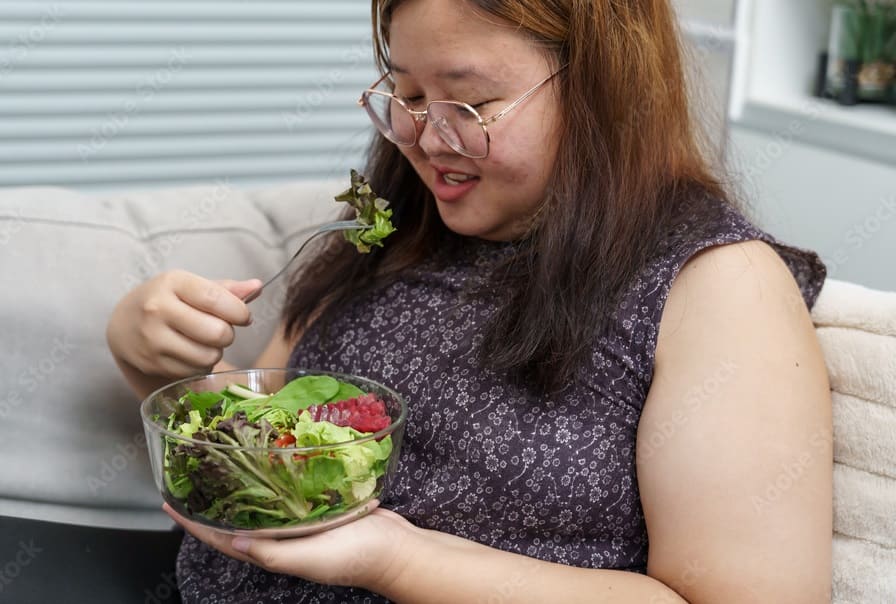So, you’ve swapped burgers for bowls of greens, added some crunch, maybe even tossed in a little grilled chicken—and yet, the scale refuses to budge. Frustrating, right?
Salads should be your go-to for weight loss. They’re light, nutrient-packed, and low in calories… or at least, that’s the idea. But here’s the surprising truth: eating salad the wrong way can actually stop—or even reverse—your weight loss progress. Here’s how eating salad the wrong way can actually work against your weight loss goals—and what you should do instead.
7 Common Salad Mistakes That Could Be Ruining Your Diet
1. Dressings: The Hidden Calorie Bombs
You’re doing great with your spinach and kale—until you drown them in creamy ranch, Thousand Island, or Caesar dressing.
What’s wrong?
- Just 2 tablespoons of creamy dressing can add 150–300 calories.
- Many dressings also contain added sugars, unhealthy fats, and preservatives.
- Bottled dressings can spike your sodium intake, causing bloating and water retention.
Try this instead:
- Make your own dressing with olive oil, vinegar, lemon juice, garlic, or mustard.
- Use Greek yogurt-based dressings for a creamy texture with more protein and less fat.
- Keep it light: toss your salad lightly instead of pouring it on top.
2. Too Many High-Calorie Toppings
Let’s be honest—cheese, croutons, candied nuts, bacon bits… they make salad exciting. But they also pile on sneaky calories.
What’s wrong?
- 1/4 cup of shredded cheese = 110+ calories
- Handful of croutons = 100–150 calories
- Glazed nuts or bacon bits = high in fat and sugar
Try this instead:
- Swap croutons with toasted chickpeas or air-popped popcorn for crunch.
- Add a sprinkle of seeds (like chia or sunflower) for texture and nutrition.
- Limit cheese to a small amount of feta, goat cheese, or shredded parmesan.
3. Lack of Protein = More Snacking Later
Eating a plain veggie salad might feel “light,” but it won’t keep you satisfied for long.
What’s wrong?
- A salad with just veggies lacks protein, which helps with satiety and muscle repair.
- You’ll likely be hungry within an hour and end up snacking on something less healthy.
Try this instead:
- Add lean protein like grilled chicken, boiled eggs, tofu, tempeh, chickpeas, tuna, or lentils.
- A small amount of quinoa can also help round out your salad with protein and fiber.
4. Too Much of a Good Thing: Portion Overload
Yes, even healthy things have limits. A salad with “clean” ingredients can still become calorie-heavy if the portions are out of control.
What’s wrong?
- Overloading with avocados, nuts, seeds, and oils can push your salad over 700–800 calories easily.
- Eating until you’re stuffed—even with healthy food—can hinder fat loss.
Try this instead:
- Stick to a balanced bowl: 50% veggies, 25% lean protein, 25% healthy fats and/or complex carbs.
- Use a small bowl or plate to help visually control portions.
5. The Sugar Trap: Dried Fruits and Glazes
Adding a bit of sweetness with dried cranberries or honey-glazed nuts might sound like a flavor win, but your blood sugar and waistline may disagree.
What’s wrong?
- Dried fruits can be concentrated sugar bombs, especially if they’re sweetened.
- Glazed nuts or flavored dressings often contain added syrups or honey.
Try this instead:
- Choose fresh fruits like apple slices, strawberries, or blueberries.
- Make your own spiced nuts at home with cinnamon or chili powder instead of sugar.
6. Using Salad as a Side, Not a Full Meal
Many people treat salad like an appetizer, then go on to eat a full main course. That defeats the purpose if weight loss is the goal.
What’s wrong?
- Eating a salad and a carb-heavy or high-fat meal means double the calories.
- Salads should help reduce calorie intake, not be an add-on.
Try this instead:
- Make your salad the main event by loading it with fiber, protein, and healthy fats.
- Add whole grains like brown rice, bulgur, or quinoa for sustained energy.
7. Sodium Overload from Store-Bought Ingredients
Prepackaged salad kits, deli meats, and canned beans can be loaded with salt.
What’s wrong?
- High sodium can cause water retention, making you feel bloated.
- It can also affect blood pressure and overall health.
Try this instead:
- Rinse canned beans before use.
- Choose fresh or frozen vegetables over pre-seasoned or processed ones.
- Limit processed meats like salami or deli ham.
Final Takeaway: Salads Can Be Super—If You Build Them Right!
Salads can be a fantastic tool for weight loss—but only when built thoughtfully. Just because it’s green doesn’t mean it’s clean. Be aware of what’s going in your bowl, and don’t let those sneaky ingredients sabotage your progress.
Here’s a quick checklist to build a weight-loss-friendly salad:
- Base of leafy greens and colorful veggies
- Lean protein source
- Small portion of healthy fats (like avocado or olive oil)
- Light, homemade or low-calorie dressing
- Optional: whole grains for extra satiety
- Herbs and spices for flavor without calories
Tell us: What’s your go-to salad combo? Or have you had a “salad fail” moment where you thought you were eating clean, but it backfired?
Also Read:
